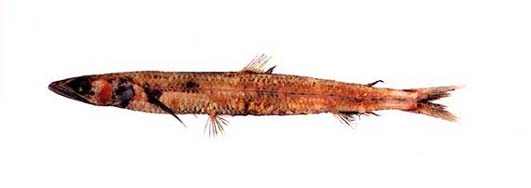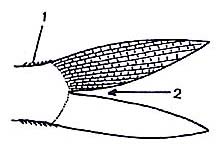デメエソ科
- HOME
- デジタル図鑑
- パタゴニア海域の重要水族
- 硬骨魚綱 ヒメ目 デメエソ科
デメエソ科(Scopelarchidae)

21 フデエソ(Fude-eso)
Scopelosaurus lepidus(Krefft et Maul, 1955)
特 徴:
背鰭11〜12軟条,臀鰭16〜19軟条,胸鰭13〜14軟条,腹鰭9軟条,側線鱗数60〜64,鰓条骨数10,鰓耙数1+1+18〜20=20〜22,脊椎骨数59〜61。頭長は体長の22.7〜24.6%,眼径は4.2〜4.7%,両眼間隔は5.1〜6.1%,吻長は6.9〜7.2%,上顎長は12.8〜13.5%,胸鰭長は15.4〜17.9%,腹鰭長は7.6〜8.5%,尾柄高は3.8〜4.7%,体高は9.2〜13.5,背鰭前長は54.9〜56.0%,臀鰭前長は78.0〜78.9%,胸鰭前長は28.9〜29.8%,腹鰭前長は48.0〜48.9%,背鰭脂鱗前長は83.9〜86.1%。体は延長して側扁する。頭はむしろ小さく,体長は頭長の4倍以上。口は大きくて斜位。下顎は上顎より前方に突出する。上顎後端は眼の中央下をわずかに越える。下顎感覚管上の孔は黒く縁どられていない。肛門の周囲をとりまく明確な黒色素は認められない。小犬歯が上顎に1列に,下顎に2列に並ぶ。上顎の外列歯はわずかに外側に向き,上顎歯よりも大きい。不規則に並ぶ1列の微小歯が口蓋骨上にある。4〜5本の小歯が鋤骨上にある。舌上に歯がない。胸鰭は長く,先端は腹鰭起部に届く。腹鰭は小さく,背鰭起部下よりかなり前方に位置する。背鰭はむしろ低く,ほぼ吻端と尾鰭後端とを結ぶ線の中央に位置する。背鰭脂鰭がある。臀鰭は体の後方にあり,尾鰭に接近して位置する。尾鰭は深く二叉する。体長約35cmに達する。
分 布:
全世界の深海中層から知られている。
備 考:
Marshall(1966a)は本種はハリーフデエソScopelosaurus hurryi(Mead)の異名ではないかと考えたが,Fujii(1984b)によれば両者は胸鰭の長さで明確に区別される。
(中村 泉)
Material examined:
4 from Argentina (301.0-349.0 mm SL), FSFL EM 205, 266, 267, 909.
Description:
D 11-12; A 16-19; P1 13-14; P2 9; LLS 60-64; BR 10; GR 1+1+18-20=20-22; ? 59-61.
HL 22.7-24.6% of SL; ED 4.2-4.7; BD 9.2-13.5; SN 6.9-7.2; IO 5.1-6.1; UJ 12.8-13.5; CP 3.8-4.7; P1L 15.4-17.9; PreD 54.9-56.0; PreA 78.0-78.9; PreP1 28.9-29.8; PreP2 48.0-48.9; Pre D adiporse 83.9-86.1.
Body elongate and compressed. Head rather small, more than 4 times in SL. Mouth large and oblique. Lower jaw extended anterior to upper jaw. Posterior margin of upper jaw extending slightly posterior to midpoint of eye. Eye large, dorsal margin forming dorsal profile of head. Sensory pores on mandibular canal not outlined by black pigment. No distinct black pigment surrounding anus. Small caniniform teeth in a series along upper jaw and in two rows on lower jaw, those in outer row larger than those on upper jaw and directed slightly outward. An irregular single row of tiny teeth on palatine. Four to five small teeth on vomer. Tongue toothless. Pectoral fin long, extended well beyond pelvic fin origin. Dorsal fin situated nearly midway between tip of snout and tip of caudal fin. Dorsal adipose fin present. Fork of caudal fin deeply notched. Attains 35 mm SL.
Distribution:
Worldwide.
Remarks:
Marshall (1966a) stated that this species may prove to be synonymous with Scopelosaurus harryi (Mead). However, Fujii (1984) showed that S. harryi has an apparently shorter pectoral fin (its posterior end not reaching the insertion of the pelvic fin) than that of S. lepidus. Six species of Scopelosaurus have been recognized so far (Marshall, 1966a).
(Izumi NAKAMURA)

Distribution of Scopelosaurus lepidus in Patagonia.

Caudal fin. Procurrent fin rays (1) and deeply notched caudal fork (2).
- 1